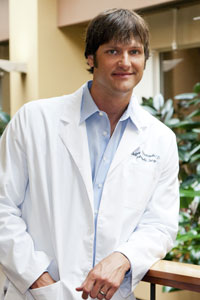Sternoclavicular (SC) Joint Injury Specialist

Are you an athlete who participates in contact sports? If so, you may be at risk of sustaining a sternoclavicular (SC) joint injury. When an SC joint injury occurs it is typically caused by a direct blow or blunt trauma to the collarbone area. SC joint injury specialist, Dr. Jeff Padalecki provides diagnosis and both surgical and nonsurgical treatment options for patients in Austin who have sustained an SC joint injury. Contact Dr. Padalecki’s team today!
Sternoclavicular Joint Injury Overview
The sternoclavicular (SC) joint is a major joint of the upper body that is formed by the articulation of the collarbone (clavicle) and the center of the chest (manubrium). Most of the SC joint’s strength and stability originates from the joint capsule and supporting ligaments. An SC joint injury is often due to a direct blow or blunt force trauma that occurs to the collarbone. These injuries can also result from a traumatic landing to the shoulder area, such as in football. A sternoclavicular joint injury is typically associated with a disruption of the supporting ligaments. Austin, Round Rock, and Cedar Park, Texas communities orthopedic shoulder specialist, Dr. Jeff Padalecki, specializes in SC joint pain and treating SC joint injuries.
A sternoclavicular joint injury is relatively uncommon, but when it occurs, the affected ligaments are stretched or torn (partially or completely) causing the joint to become disrupted. An SC joint injury is graded into 3 types ranging from a first-degree injury that involves a simple sprain or stretching of the ligaments to a second-degree injury where a portion of the clavicle becomes subluxated. In the most severe cases, a third degree SC joint injury, a complete rupture typically occurs between the sternoclavicular and costoclavicular ligaments, which allows the clavicle to completely dislocate from the manubrium.
What are Examples of SC Joint Injuries?
Some examples of SC joint injuries include:
What are the Symptoms of a Sternoclavicular Joint Injury?
The most common symptoms from an SC joint injury include:
- Severe SC joint pain at or around the joint at the time of injury and afterwards
- Bruising in the area
- Difficulty swallowing, difficulty breathing, a sense of fullness around the neck or a feeling of choking sensation due to posterior displacement of the medial clavicle
- Cracking noises and/or popping sounds
- A feeling of instability where the clavicle feels like it “moves” during activities
How are SC Joint Injuries Diagnosed?
Dr. Padalecki will conduct a thorough examination of the shoulder blade and collarbone. He will test for tenderness and SC joint pain, and evaluate the overall range of motion of the arm and shoulder. In some cases, he will be able to see if a dislocation or other major disruption has occurred, but an X-ray will usually confirm his diagnosis. Because ligaments and other soft tissue structures are typically involved with a sternoclavicular joint injury, he may also order an MRI to take a more in-depth look at this area.
How is a Sternoclavicular Joint Injury Treated?
Non-Surgical
Surgery is not necessary for most SC joint injuries. Initial treatment consists of ice, pain medication and sling immobilization. Return to activity is based on type of sport and the position played, the arm injured (dominant versus non-dominant) and the severity of the injury. In more acute cases, a reduction (or relocation) of the SC joint can be attempted by sedating the patient and pulling gently on the arm, manipulating it back into its normal position. This may allow the SC joint to ‘pop’ back into position.
Surgical
Operative treatment is reserved for patients who experience major trauma to the bones and ligaments of the SC joint. Dr. Padalecki will choose the type of surgery based on the exact injury, but in many cases will opt for a stabilization procedure that will allow him to reattach or repair any loose or torn ligaments of the SC joint. Without this stabilization procedure, a patient is at risk for future dislocations and/or subluxations, as well as the onset of arthritis.
What Happens After Surgery for an SC Joint Injury?
Following surgery for an SC joint injury, it is critical that patients follow the prescribed post-op rehabilitation program as set forth by Dr. Padalecki. These guidelines will be broken down into phases and will be conducted with a therapist and at home. Most patients are able to resume normal activities within 3-6 months; sports and other high impact activities may take longer.
For more information on a sternoclavicular joint injury, or for additional resources on causes of SC joint pain, contact the office of Dr. Jeff Padalecki, shoulder specialist in Austin, Texas.